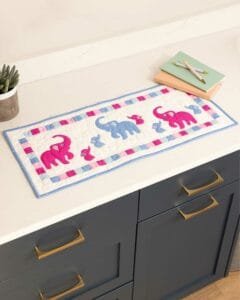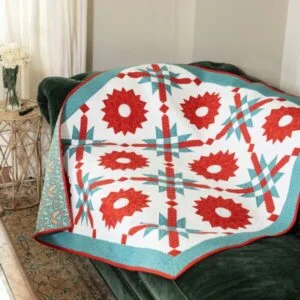The Kashmir Quilt Pattern is a stunning design that evokes the rich cultural heritage and intricate artistry of Kashmir. In this Kashmir Quilt Pattern – Tutorial, you’ll learn how to create this beautiful quilt that incorporates both geometric shapes and floral motifs.
Whether you’re an experienced quilter or just getting started, this tutorial will guide you through the process of creating a quilt that’s both elegant and meaningful.
The Kashmir Quilt Pattern is known for its detailed and symmetrical design, often featuring vibrant colors and intricate patterns that resemble traditional Kashmiri textiles.

By following this tutorial, you will not only master the Kashmir Quilt Pattern but also gain insights into the techniques that make this style unique.
Throughout this Kashmir Quilt Pattern – Tutorial, we will break down the steps, from gathering materials to finishing your quilt, with helpful tips along the way to ensure your quilt turns out beautifully. Let’s dive into the world of this mesmerizing pattern and create something truly special.
1. Gathering Materials for the Kashmir Quilt Pattern
Before diving into the process of making the Kashmir Quilt Pattern, it’s essential to gather all the materials you’ll need to complete the project. Having the right materials at hand will ensure that the quilting process goes smoothly.
- Selecting Your Fabric: The Kashmir Quilt Pattern stands out because of its use of rich, vibrant colors and bold contrasts. When selecting your fabrics, opt for colors that reflect the traditional Kashmiri style, such as deep reds, blues, and greens. It’s important to choose fabrics with good contrast to highlight the intricate patterns.
- Cutting Tools: Accurate cutting is critical for any quilt pattern, but especially for the Kashmir Quilt Pattern due to its intricate designs. Invest in a good rotary cutter, a self-healing cutting mat, and a ruler to ensure precise cuts.
- Sewing Machine: A reliable sewing machine is essential. Make sure your machine is equipped with a ¼-inch foot, as precise seams are key to achieving a professional look for the Kashmir Quilt Pattern.
- Pins and Clips: Keep your fabric pieces in place as you sew using pins or sewing clips. This will help ensure that your seams remain straight and your pieces don’t shift while you work.
- Thread and Needles: Use high-quality cotton thread in a color that complements your fabric choices. Cotton thread is strong and durable, making it ideal for quilting projects like the Kashmir Quilt Pattern.
- Iron and Pressing Tools: Pressing your seams as you work will help create a smooth and flat quilt top. A small, portable ironing board or pressing mat is a great tool to have next to your sewing station.
2. Cutting and Preparing the Fabric Pieces
Once your materials are ready, it’s time to begin cutting and preparing the fabric for your Kashmir Quilt Pattern. This step is crucial to ensure that your quilt turns out with clean lines and a professional appearance.
- Cutting the Main Blocks: For the Kashmir Quilt Pattern, you’ll need to cut a series of large squares that will form the base of your quilt. These squares are typically between 10 to 12 inches in size, depending on the overall dimensions of your quilt.
- Creating the Floral Motifs: One of the key features of the Kashmir Quilt Pattern is its intricate floral designs. You’ll need to cut smaller fabric pieces that will be used to create these motifs. These can be done using applique techniques or precise cutting for piecing.
- Cutting the Border Strips: To frame your quilt and give it a polished look, cut border strips from a contrasting fabric. These strips should be cut to match the size of your quilt blocks, typically between 2 to 4 inches wide, depending on your desired border size.
- Laying Out Your Pieces: Before you start sewing, lay out all of your quilt blocks and floral motifs. This will allow you to visualize the final design and make any adjustments before you begin sewing the pieces together.
- Marking Seams: Marking your seam lines on the back of your fabric pieces will help ensure that your seams are straight and even. Use a fabric marker or chalk to lightly mark the seam lines.
- Checking for Accuracy: Double-check your measurements and fabric pieces before moving on to sewing. This will save you time later on and prevent any mistakes that could affect the final design of your quilt.
3. Sewing the Kashmir Quilt Pattern
Now that your fabric pieces are cut and ready, it’s time to start assembling your Kashmir Quilt Pattern. This step requires attention to detail, but with patience, you’ll create a quilt that is both beautiful and well-constructed.
- Sewing the Main Blocks: Start by sewing the large squares together to form the base of your quilt. Use a ¼-inch seam allowance and press your seams as you go to ensure that everything lies flat.
- Adding the Floral Motifs: Once your main blocks are assembled, it’s time to add the floral motifs. These can be sewn onto the quilt using an applique method, or you can piece them together with the rest of the quilt blocks. Take your time with this step to ensure that the motifs are centered and aligned properly.
- Sewing the Border Strips: Next, add the border strips to frame your quilt. Sew the strips to the edges of your quilt blocks, ensuring that the seams are aligned and the borders are straight.
- Pressing the Seams: After each step, press your seams carefully to ensure that your quilt top remains flat. This will make it much easier to sew the quilt together in the final assembly.
- Piecing the Quilt Top Together: Once all the individual pieces are sewn together, it’s time to piece the entire quilt top. Sew the rows of quilt blocks together, ensuring that all seams are aligned and the blocks match up perfectly.
- Final Pressing: Before moving on to the next step, give your quilt top one final press. This will ensure that everything lies flat and that your quilt has a professional, finished look.
4. Quilting and Finishing the Kashmir Quilt
With the quilt top assembled, it’s time to move on to the final steps of the Kashmir Quilt Pattern – Tutorial. This includes layering, quilting, and binding to complete your quilt.
- Creating the Quilt Sandwich: The quilt sandwich consists of three layers: the quilt top, batting, and backing fabric. Lay the backing fabric down first, followed by the batting and then the quilt top. Smooth out any wrinkles and pin the layers together to keep them from shifting.
- Quilting the Layers Together: Quilting the layers together can be done by hand or with a sewing machine. For the Kashmir Quilt Pattern, consider using decorative stitching that complements the intricate design of the quilt top. Straight lines, echo quilting, or free-motion quilting are all great options.
- Trimming the Edges: After quilting, trim the excess fabric and batting from the edges of your quilt. This will give the quilt a clean, even edge that is ready for binding.
- Adding the Binding: To finish the edges of your quilt, add a binding. Cut strips of fabric and sew them to the edges of the quilt, folding them over to create a clean, finished edge. Make sure the binding is securely sewn in place for durability.
- Final Pressing: Once the binding is complete, give your quilt a final press to smooth out any wrinkles and ensure a professional appearance.
- Admiring Your Finished Quilt: Take a moment to admire your finished Kashmir Quilt! You’ve created a beautiful, intricate quilt that reflects the rich artistry of Kashmir.
FAQ
What is the Kashmir Quilt Pattern?
The Kashmir Quilt Pattern is a quilt design inspired by traditional Kashmiri textiles. It often features intricate floral motifs, geometric shapes, and vibrant colors, making it a beautiful and unique choice for quilters.
Is the Kashmir Quilt Pattern suitable for beginners?
While the Kashmir Quilt Pattern is intricate, it can be adapted for quilters of all skill levels. Beginners may want to simplify the design by using fewer motifs, while more experienced quilters can embrace the challenge of the detailed pattern.
What fabrics should I use for the Kashmir Quilt Pattern?
The Kashmir Quilt Pattern looks best with fabrics that have a rich, bold color palette. Choose fabrics with high contrast to make the intricate patterns stand out, and consider using both solids and prints to add visual interest.
How long does it take to complete the Kashmir Quilt Pattern?
The time it takes to complete the Kashmir Quilt Pattern will depend on your skill level and the complexity of your design. On average, it could take anywhere from a few weeks to a couple of months to finish, depending on how much time you dedicate to the project.
What size should the Kashmir Quilt be?
The size of the Kashmir Quilt can vary depending on your preferences. You can create a smaller version for a wall hanging or a larger version for a full-sized bed. The pattern is highly adaptable, allowing you to adjust the size to fit your needs.
Can I customize the Kashmir Quilt Pattern?
Yes! One of the great things about the Kashmir Quilt Pattern is its versatility. You can customize the design by changing the colors, adding or removing motifs, or adjusting the size of the blocks. This allows you to create a quilt that is truly unique.
Join our VIP broadcast list and gain access to exclusive patterns, all for free. As a VIP member, you’ll receive the best patterns daily, delivered directly to your device. ✨📱 It’s a unique opportunity to stay up-to-date with the latest trends and designs, curated just for you. Don’t miss out on enhancing your projects and discovering new inspirations with the best patterns every day! 🎨🔝
Conclusion
In this Kashmir Quilt Pattern – Tutorial, we’ve explored the step-by-step process of creating a stunning quilt inspired by the rich cultural heritage of Kashmir. From gathering the right materials to sewing intricate motifs and finishing your quilt, this tutorial provides all the guidance you need to create a beautiful quilt. We hope this tutorial was helpful and inspiring!
Please share your feedback and suggestions in the comments below. How did your Kashmir Quilt turn out? We’d love to hear from you!



